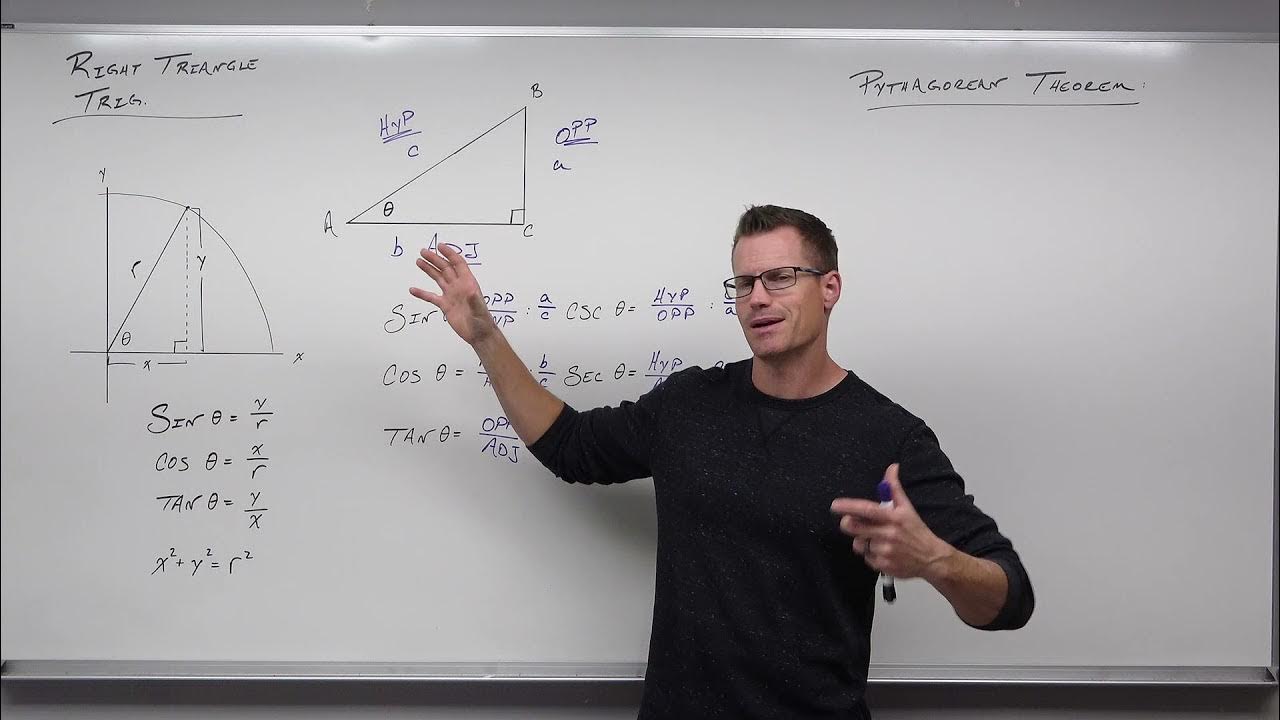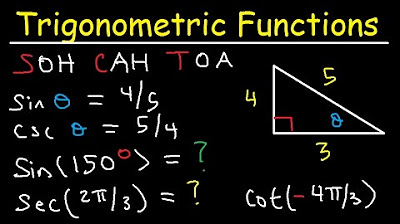Trigonometry Concepts - Don't Memorize! Visualize!
TLDRIn this informative video, Dennis Davis introduces essential trigonometry concepts, focusing on angles and their relationships with triangles. He explains the six trigonometric functions—sine, cosine, tangent, cotangent, secant, and cosecant—using the memorable sohcahtoa mnemonic. Davis emphasizes the unitless nature of trig functions and their application beyond triangles, using the Pythagorean theorem and the unit circle for visualization. The video serves as a solid foundation for those new to trigonometry or a review for those needing a refresher.
Takeaways
- 📐 Trigonometry, often abbreviated as 'trig,' is fundamentally about angles and their measurements using triangles.
- 🔢 The six trigonometric functions are sine, cosine, tangent, cotangent, secant, and cosecant, each representing a ratio between the sides of a right triangle.
- 📚 A popular mnemonic for remembering the first three trig functions is 'sohcahtoa,' which stands for sine (opposite/hypotenuse), cosine (adjacent/hypotenuse), and tangent (opposite/adjacent).
- 🌈 The last three trig functions (cosecant, secant, and cotangent) are the reciprocals of the first three: cosecant (1/sine), secant (1/cosine), and cotangent (1/tanget).
- 📈 Trigonometric functions are unitless, as they represent ratios between lengths, and are therefore dimensionless.
- 📊 Trig functions are mathematical functions, but unlike other functions, they are usually written without parentheses around their arguments.
- 📐📍 In the Cartesian coordinate system, points are identified by their (x, y) coordinates, and the axes divide the plane into four quadrants.
- 🔢 Degrees and radians are two ways to measure angles; a full circle is 360 degrees or 2π radians.
- 📐 The unit circle, with a radius of one, is a fundamental concept in trigonometry, allowing direct reading of sine and cosine values from the x and y coordinates of points on its circumference.
- 🌟 The Pythagorean theorem is crucial in trigonometry, stating that in a right triangle, the square of the hypotenuse's length is equal to the sum of the squares of the other two sides' lengths.
- 🎨 Each trig function is assigned a color as a memory aid: sine (red), cosine (blue), and the rest follow the pattern of their reciprocal functions.
Q & A
What is the meaning of the word 'trigonometry'?
-Trigonometry, often abbreviated as 'trig', means triangle measurement. It is a branch of mathematics that primarily deals with the relationships between the angles and sides of triangles, particularly right-angled triangles.
How are angles typically denoted in trigonometry?
-In trigonometry, angles are usually denoted by a Greek letter, with the Greek letter theta (θ) being a common choice.
What are the six trigonometric functions?
-The six trigonometric functions are sine (sin), cosine (cos), tangent (tan), cotangent (cot), secant (sec), and cosecant (csc). They represent various ratios between the lengths of the sides of a right triangle.
What is the mnemonic 'sohcahtoa' used for?
-The mnemonic 'sohcahtoa' is used to remember the first three trigonometric functions: sine (soh), cosine (cah), and tangent (toa). Each part of the mnemonic represents the ratio of the opposite side to the hypotenuse for sine, the adjacent side to the hypotenuse for cosine, and the opposite side to the adjacent side for tangent.
What are the Pythagorean theorem and its significance in trigonometry?
-The Pythagorean theorem states that in a right triangle, the square of the length of the hypotenuse (the side opposite the right angle) is equal to the sum of the squares of the lengths of the other two sides. This theorem is fundamental in trigonometry as it relates to the ratios that define the trigonometric functions.
What is a unit circle and how does it simplify trigonometric calculations?
-A unit circle is a circle with a radius of one unit. It simplifies trigonometric calculations because the hypotenuse of the right triangle formed with the circle and the x-axis is 1, making the sine and cosine values equal to the lengths of the opposite and adjacent sides, respectively, of the triangle.
How are angles measured in radians?
-Angles are measured in radians by considering the length of the arc of a circle that the angle subtends. One full circle (360 degrees) is equivalent to 2π radians. The relationship between degrees and radians is such that 180 degrees is equal to π radians, 90 degrees is equal to π/2 radians, and so on.
What are the quadrants in the Cartesian coordinate system and how do they affect the signs of trigonometric functions?
-The Cartesian coordinate system divides the plane into four quadrants, labeled with Roman numerals I, II, III, and IV. In each quadrant, the signs of the trigonometric functions (sine and cosine) change. For example, in Quadrant I, both sine and cosine are positive; in Quadrant II, cosine is negative and sine is positive; in Quadrant III, both are negative; and in Quadrant IV, cosine is positive and sine is negative.
How does the concept of a unit circle help in understanding the trigonometric functions?
-The unit circle allows us to directly read the values of sine and cosine for any given angle by looking at the coordinates of the point on the circle where the angle's terminal side intersects the circle. Since the radius is 1, the sine value is the y-coordinate of that point, and the cosine value is the x-coordinate.
What is the relationship between the trigonometric functions and their reciprocals?
-The last three trigonometric functions (cotangent, secant, and cosecant) are the reciprocals of the first three (tangent, cosine, and sine), respectively. This means that the cosecant is the reciprocal of sine (1/sin), the secant is the reciprocal of cosine (1/cos), and the cotangent is the reciprocal of tangent (1/tan).
How can one quickly determine the sine and cosine values for angles at 30, 45, and 60 degrees?
-For angles at 30, 45, and 60 degrees, the sine and cosine values can be quickly determined by remembering the special right triangles associated with these angles. For a 30-degree angle, sine is 1/2 and cosine is √3/2. For a 45-degree angle, both sine and cosine are √2/2. For a 60-degree angle, sine is √3/2 and cosine is 1/2.
Outlines
📚 Introduction to Trigonometry
The video begins with an introduction to trigonometry, emphasizing its focus on angles rather than triangles. Dennis Davis explains that trigonometry is about 'triangle measurement' but actually revolves around angles. He introduces the concept of an imaginary triangle created by an angle and uses a paper cutter analogy to describe the trigonometric functions of the angle. The six trigonometric functions (sine, cosine, tangent, cotangent, secant, and cosecant) are defined as ratios between the lengths of the triangle's sides, with mnemonics like 'sohcahtoa' to help remember their relationships.
📐 Understanding Trigonometric Functions
This paragraph delves deeper into the properties of trigonometric functions, clarifying that they are unitless and properties of angles rather than triangles. Dennis Davis explains the common shorthand for trig functions and how to square them using the Pythagorean theorem. He also introduces the concept of quadrants in the Cartesian coordinate system and their relevance to evaluating trig functions. The explanation includes a detailed look at expressing and measuring angles in degrees, with a focus on common angles and the 30-60-90 and 45-degree angles.
🌐 Radians and the Unit Circle
The speaker transitions to discussing radians as a unit of measure for angles, contrasting them with degrees. He explains the concept of a unit circle with a radius of one and how it simplifies the trigonometric functions. The paragraph covers the conversion between degrees and radians, providing examples and a table to illustrate the relationship between common angles in degrees and their radian equivalents. The unit circle's role in simplifying trigonometric functions is emphasized, with sine and cosine values directly read from the circle's coordinates.
📐 Trigonometric Ratios and the Pythagorean Theorem
Dennis Davis discusses the Pythagorean theorem's significance in trigonometry, particularly for right triangles. He provides an example with a 3-4-5 triangle to illustrate the theorem. The paragraph also introduces the concept of the unit circle and its simplification of trigonometric functions, where the hypotenuse is 1. The speaker explains how the sine and cosine of an angle can be directly read from the unit circle as the lengths of the opposite and adjacent sides, respectively. Additionally, he introduces the tangent function as the ratio of sine to cosine.
🔢 Memorizing Trigonometric Values
The speaker advises against memorizing trigonometric values, instead suggesting understanding the patterns and relationships between angles and their sine and cosine values. He uses the unit circle to demonstrate how to determine the values for angles in the first quadrant, associating them with 'large', 'medium', and 'small' numerical values. The paragraph emphasizes the importance of visualizing the unit circle and understanding the coordinate relationships to quickly determine trigonometric values without memorization.
🎥 Summary and Future Content
In the concluding paragraph, Dennis Davis summarizes the key points covered in the video, which serves as a foundation for understanding trigonometry and its graphical representation. He reiterates the importance of not memorizing but rather understanding the concepts and relationships. The speaker also promotes his upcoming video series on the graphical representation of trigonometric functions and encourages viewers to share the video with others who might benefit from the information.
Mindmap
Keywords
💡Trigonometry
💡Angles
💡Trigonometric Functions
💡Right Triangle
💡Mnemonics
💡Unit Circle
💡Pythagorean Theorem
💡Degrees and Radians
💡Cartesian Coordinate System
💡Quadrants
Highlights
Trigonometry is about angles, using triangles to define concepts.
The six trigonometric functions are based on ratios between the lengths of sides of a right triangle.
The mnemonic 'sohcahtoa' helps remember the first three trig functions: sine, cosine, and tangent.
The last three trig functions are reciprocals of the first three: cosecant, secant, and cotangent.
Trig functions are properties of angles, not triangles, and are unitless.
Trig functions are written without parentheses and squared functions are written with the exponent between the abbreviation and the angle variable.
The Cartesian coordinate system is used to define points in a plane with x and y coordinates.
Angles are measured in degrees and radians, with 2π radians making a complete circle.
The unit circle, a circle with radius one, simplifies trig functions by making the hypotenuse equal to 1.
The Pythagorean theorem is fundamental in trigonometry, relating the squares of the lengths of the sides of a right triangle.
The paper-cutter illustration is a helpful way to visualize the creation of right triangles for trig functions.
The sine and cosine of specific angles can be easily determined without memorization using patterns and the unit circle.
The video aims to provide a foundation for understanding trig functions without memorization, focusing on visualizing and understanding concepts.
The speaker, Dennis Davis, introduces a color-coding system for trig functions to aid in memorization and understanding.
The video is part of a series on visualizing trigonometric functions, offering both a review and a foundation for those new to trigonometry.
Transcripts
Browse More Related Video

Introduction to Right Triangle Trigonometry (Precalculus - Trigonometry 30)

Trigonometric Functions of Any Angle - Unit Circle, Radians, Degrees, Coterminal & Reference Angles

Trigonometry

Evaluating Trigonometric Functions Given a Point on the Terminal Side - Trigonometry

A Simple Trick To Remember Trigonometry Values

Trig - 0.6 Trig Functions of Acute Angles
5.0 / 5 (0 votes)
Thanks for rating: